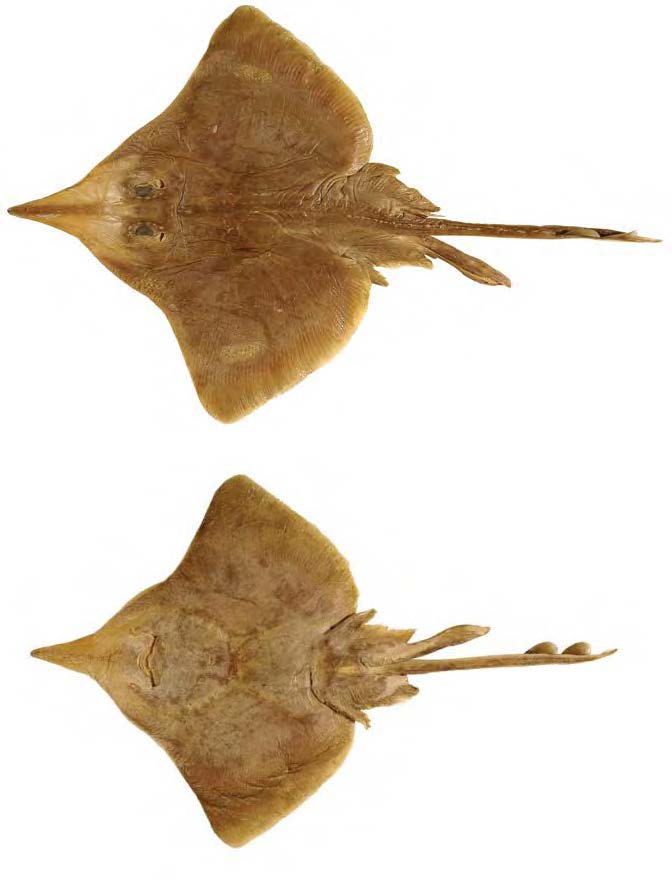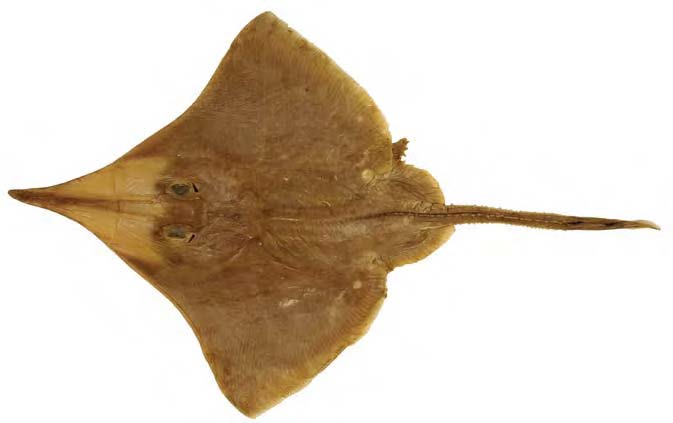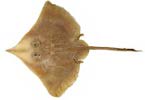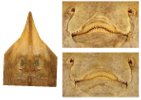Dipturus queenslandicus
Last, White & Pogonoski, 2008
Queensland deepwater skate
Classification: Elasmobranchii Rajiformes Rajidae
Reference of the original description
New skates of the genus Dipturus (Rajoidei: Rajidae) from Australian Seas. CSIRO Marine and Atmospheric Research Paper, 21, 9–52
New skates of the genus Dipturus (Rajoidei: Rajidae) from Australian Seas. CSIRO Marine and Atmospheric Research Paper, 21, 9–52
Image of the original description

Dipturus queenslandicus sp. nov, adult male holotype (CSIRO H 715–07, 634 mm TL, preserved): A, dorsal surface; B, ventral surface. NB. right clasper removed. In: Last, P.R. & White, W.T. & Pogonoski, J.J. 2008 New skates of the genus Dipturus (Rajoidei: Rajidae) from Australian Seas. CSIRO Marine and Atmospheric Research Paper, 21: 9-52

Dipturus queenslandicus sp. nov, adult male holotype (CSIRO H 715–07, 634 mm TL, preserved): A, dorsal surface; B, ventral surface. NB. right clasper removed. In: Last, P.R. & White, W.T. & Pogonoski, J.J. 2008 New skates of the genus Dipturus (Rajoidei: Rajidae) from Australian Seas. CSIRO Marine and Atmospheric Research Paper, 21: 9-52
Types
Dipturus queenslandicus
Holotype: CSIRO: H 715-07; Paratype: CSIRO: H 957-01; CSIRO: H 720-34; CSIRO: H 947-13; CSIRO: H 715-04; CSIRO: H 715-02; CSIRO: H 715-10; CSIRO: H 715-09; CSIRO: H 715-06; CSIRO: H 715-01; QM: I 19985; QM: I 18527;
Dipturus queenslandicus
Holotype: CSIRO: H 715-07; Paratype: CSIRO: H 957-01; CSIRO: H 720-34; CSIRO: H 947-13; CSIRO: H 715-04; CSIRO: H 715-02; CSIRO: H 715-10; CSIRO: H 715-09; CSIRO: H 715-06; CSIRO: H 715-01; QM: I 19985; QM: I 18527;
Description :
Citation: Dipturus queenslandicus Last, White & Pogonoski, 2008: In: Database of modern sharks, rays and chimaeras, www.shark-references.com, World Wide Web electronic publication, Version 01/2026
Please send your images of "Dipturus queenslandicus" to info@shark-references.com

Dorsal surface of Dipturus queenslandicus sp. nov. primary female paratype (CSIRO H 720–34, 753 mm TL, preserved); In: Last, P.R. & White, W.T. & Pogonoski, J.J. 2008 New skates of the genus Dipturus (Rajoidei: Rajidae) from Australian Seas. CSIRO Marine and Atmospheric Research Paper, 21: 9-52

Dorsal surface of Dipturus queenslandicus sp. nov. primary female paratype (CSIRO H 720–34, 753 mm TL, preserved); In: Last, P.R. & White, W.T. & Pogonoski, J.J. 2008 New skates of the genus Dipturus (Rajoidei: Rajidae) from Australian Seas. CSIRO Marine and Atmospheric Research Paper, 21: 9-52
Common names
 Queensland deepwater skate
Queensland deepwater skate
 Queensland deepwater skate
Queensland deepwater skate
Short Description
Original diagnosis of LAST, WHITE & POGONOSKI, 2008 [3309]: A medium-sized species of Dipturus (to 76 cm TL) with the following combination of characters: disc relatively broad with angular to narrowly rounded apices, width 62–66% TL, 1.0–1.1 times its length; snout angle 62–67°; tail length 0.6–0.8 in distance from snout tip to rear of cloaca; tail relatively slender, width 1.3–1.9 times height at its midlength, 1.0–1.9 times at first dorsal-fin origin; pre-upper jaw length 20–26% TL, 2.6–3.4 times internasal width; ventral head length 34– 39% TL; snout length 4.9–6.1 times interorbital width; orbit diameter 66–76% interorbital width; first dorsalfin height 1.5–2.0 in its base length; distance from first dorsal-fin origin to tail tip 3.2–3.6 times first dorsal-fin base length, 2.7–3.4 times caudal-fin length; pelvic fins of medium size, length of posterior lobe of adult males 16% TL, length of anterior lobe 67–70% of posterior lobe; adult clasper moderately elongate, 24% TL, connected to pelvic-fin inner margin at about 30–43% of its length from cloaca; anterior margins of both surfaces of disc of adult males with bands of granular denticles; usually 1–2 nuchal thorns; malar thorn patch well-developed, alar patch short; tail with a single thorn row in males, usually with 1–2 additional pairs of lateral rows in large females; total pectoral radials 77–80; trunk centra 26–29; predorsal centra 74–79; total centra 127–136; tooth rows in upper jaw 34–39; mainly uniformly greyish brown dorsally; ventrally mostly greyish or brownish (somewhat blotchy), snout tip mostly pale; ventral sensory pores small, black-edged, obvious, not surrounded by indistinct dusky blotches; dorsal fins blackish, caudal fin mostly whitish.
Original diagnosis of LAST, WHITE & POGONOSKI, 2008 [3309]: A medium-sized species of Dipturus (to 76 cm TL) with the following combination of characters: disc relatively broad with angular to narrowly rounded apices, width 62–66% TL, 1.0–1.1 times its length; snout angle 62–67°; tail length 0.6–0.8 in distance from snout tip to rear of cloaca; tail relatively slender, width 1.3–1.9 times height at its midlength, 1.0–1.9 times at first dorsal-fin origin; pre-upper jaw length 20–26% TL, 2.6–3.4 times internasal width; ventral head length 34– 39% TL; snout length 4.9–6.1 times interorbital width; orbit diameter 66–76% interorbital width; first dorsalfin height 1.5–2.0 in its base length; distance from first dorsal-fin origin to tail tip 3.2–3.6 times first dorsal-fin base length, 2.7–3.4 times caudal-fin length; pelvic fins of medium size, length of posterior lobe of adult males 16% TL, length of anterior lobe 67–70% of posterior lobe; adult clasper moderately elongate, 24% TL, connected to pelvic-fin inner margin at about 30–43% of its length from cloaca; anterior margins of both surfaces of disc of adult males with bands of granular denticles; usually 1–2 nuchal thorns; malar thorn patch well-developed, alar patch short; tail with a single thorn row in males, usually with 1–2 additional pairs of lateral rows in large females; total pectoral radials 77–80; trunk centra 26–29; predorsal centra 74–79; total centra 127–136; tooth rows in upper jaw 34–39; mainly uniformly greyish brown dorsally; ventrally mostly greyish or brownish (somewhat blotchy), snout tip mostly pale; ventral sensory pores small, black-edged, obvious, not surrounded by indistinct dusky blotches; dorsal fins blackish, caudal fin mostly whitish.
Remarks
shark-references Species-ID=2030;
shark-references Species-ID=2030;


















